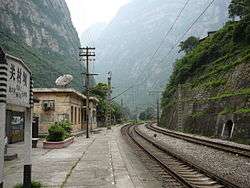Chengdu–Kunming Railway



The Chengdu–Kunming Railway or Chengkun Railway (simplified Chinese: 成昆铁路; traditional Chinese: 成昆鐵路; pinyin: chéngkūn tiělù), is a major trunkline railroad in southwestern China between Chengdu, the capital of Sichuan Province and Kunming, the capital of Yunnan Province. The line is 1,134 km (705 mi) long and traverses rugged terrain from the Sichuan Basin to the Yunnan-Guizhou Plateau.[1] The line was built between 1958 and 1970. Major cities along route include Chengdu, Pengshan, Jiajiang, Emei, Ebian, Ganluo, Xide, Xichang, Dechang, Miyi and Panzhihua in Sichuan Province and Yuanmou, Lufeng, Anning and Kunming in Yunnan Province.
History

Planning of the Chengdu–Kunming Railway began in 1952 with several routes under consideration.[1] The western-most route over the most difficult terrain was selected in 1956. Construction began in 1958 during the Great Leap Forward and expanded to full-scale in 1964. In July 1970, the line was completed and entered into operation in January 1971.[1] The government published a pictorial in 1976 showing pictures of the construction and extreme terrain that required hundreds of tunnels and bridges. [2] Building conditions were hazardous and 2,100 workers perished during the construction of the original line.[3] On August 30, 2000, the entire line was electrified.[1] Aside from Chengdu and Kunming, the line has a total of 122 stations.[1]
Sculpture
.jpg)
In 1974, an ivory sculpture commemorating the completion of the Chengdu–Kunming Railway was presented as a gift to the United Nations and is displayed at the U.N. Headquarters in New York.[4] The sculpture depicts the rail bridge across the Dadu River between two mountain peaks, with intricate details of passengers inside the train.[5] The sculpture, 150 cm in length and 110 cm in height, was made from eight elephant tusks and weighs over 300 kilograms.[4]
Railway junctions
The Chengkun Railway is a major trunkline in China's railway network and connects with numerous other railway lines including:
Sichuan Province
Yunnan Province
- Guangtong: Guangtong–Dali Railway
- Kunming: Shanghai–Kunming Railway, Nanning-Kunming Railway, Kunming–Yuxi Railway
See also
References
- 1 2 3 4 5 《中国铁路线》 P25-26 Last Accessed 2011-07-31
- ↑ "Mountains and Rivers Make Way: The Chengtu-Kunming Railroad in Photographs," published by the Foreign Languages Press (Peking: 1976).
- ↑ (Chinese) "成昆铁路:生命铺就的英雄史诗" Archived May 23, 2011, at the Wayback Machine. Last Accessed 2011-07-31
- 1 2 "Chinese Ivory Carving" UN.org Archived August 24, 2011, at the Wayback Machine. Last Accessed 2011-07-31
- ↑ "China Presents Ivory Carving to United Nations" Last Accessed 2011-07-31
External links
-
 Media related to Chengdu–Kunming Railway at Wikimedia Commons
Media related to Chengdu–Kunming Railway at Wikimedia Commons - Documentary on the construction of the Chengkun Railway